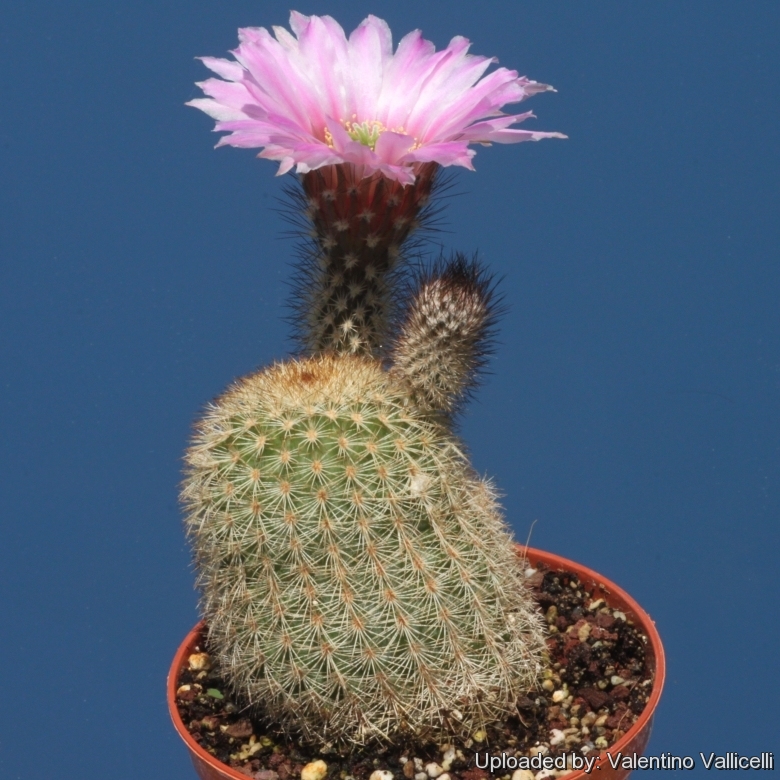
Echinocereus grandis Photo by: Valentino Vallicelli
The plants coming from San Lorenzo Island often have rosy-coloured to pink/violet flowers.
Origin and Habitat: The species is endemic to the Islands of San Esteban in Sonora, and Las Animas ("San Lorenzo norte") and San Lorenzo in Baja California (Mexico). It is unclear though whether the plant is actually to be found growing on the Baja California mainland, or whether it is only an islands based endemic, like some other species.
Type locality: San Esteban Island.
Habitat: Dry creek bed, beach and low hills in desert scrub on the islands. Echinocereus grandisSN|21834]]SN|21834]] has a very restricted range, and at present there are no major threats. However, there is a potential threat from an invasive grass specie s- Buffel Grass (Pennisetum ciliare). The species is abundant over the entire islands.
Synonyms:
Common Names include:
ENGLISH: San Pedro Nolasco Hedgehog Cactus, Giant Hedgehog Cactus, Giant Rainbow Cactus
Description: Echinocereus grandisSN|21834]]SN|21834]] is one of the largest of the upright-stemmed hedgehog cacti, It is solitary, or occasionally branched to form small clusters up to 15 stems, the branches grows from the base. It is not the longest-stemmed, but it is the most massive. The stems sometimes lay down under their own weight. Plants in cultivation often grows for a long time with single solitary columnar stems.
Stems: Sub-cylindric,10-50 cm tall, 8-12 cm in diameter.
Ribs: (18 to) 21 to 25 low.
Areoles: Large, elongated, close-set approx 1 cm apart.
Spines: Dull white to cream-coloured quite short, spreading, and stiff.
Central spines: Very slender light-colored 8 to 12 often in two rows.
Radial spines: 15 to 25 radials, 1-10 mm long pressed next to the skin.
Flowers: Diurnal, narrowly funnelform, white or pale yellow with greenish base, unusually narrow, 5-8 cm in diameter, 5-7 cm long, near the stem tips. The plants coming from San Lorenzo Island often have rosy-coloured to pink/violet flowers. The pericarpel is densely covered with straw coloured spines and white hairs. Filaments green, style white, stigma lobes green. Floral remains are difficult to detach from the plant and can set up stem rot.
Blooming season: It flowers annually in March-April, the flowers remain open for 2 or 3 days. Blooming generally begins 7 to 10 years after sowing, as the plant matures.
Fruits: The fruits are very spiny.
Notes: E. grandis is very similar to Echinocereus websterianusSN|1723]]SN|1723]] and some authors have linked these two species, being uncertain of whether they are in fact one or two species.
Bibliography: Major references and further lectures
1) Edward F. Anderson: The Cactus Family. Timber Press, Portland (Oregon) 2001
2) James Cullen, Sabina G. Knees, H. Suzanne Cubey "The European Garden Flora Flowering Plants: A Manual for the Identification of Plants Cultivated in Europe, Both Out-of-Doors and Under Glass" Cambridge University Press, 11/Aug/2011
3) David R Hunt; Nigel P Taylor; Graham Charles; International Cactaceae Systematics Group. "The New Cactus Lexicon" dh books, 2006
4) Nigel P. Taylor “The Genus Echinocereus” Royal Botanic Gardens, Kew, 1985
5) Burquez Montijo, A. & Felger, R.S. 2013. Echinocereus grandis. The IUCN Red List of Threatened Species. Version 2014.3. <www.iucnredlist.org>. Downloaded on 25 May 2015
6) Frank, G.R.W. (1986): “Die Echinocereen von Baja California” - Kakt. and. Sukk. 37 (5): 90-98
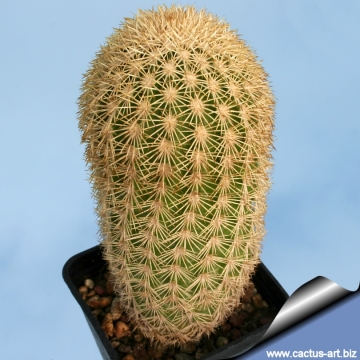 Echinocereus grandis Photo by: Cactus Art
Echinocereus grandis Photo by: Cactus Art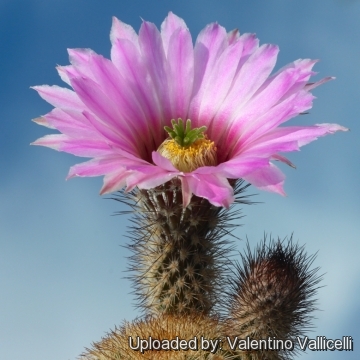 San Lorenzo Island: this population has rosy-coloured to pink/violet flowers. Photo by: Valentino Vallicelli
San Lorenzo Island: this population has rosy-coloured to pink/violet flowers. Photo by: Valentino Vallicelli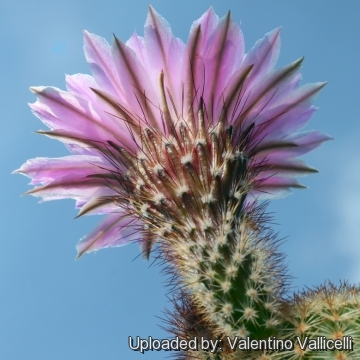 Pericarpel is densely covered with spines and white hairs. Photo by: Valentino Vallicelli
Pericarpel is densely covered with spines and white hairs. Photo by: Valentino Vallicelli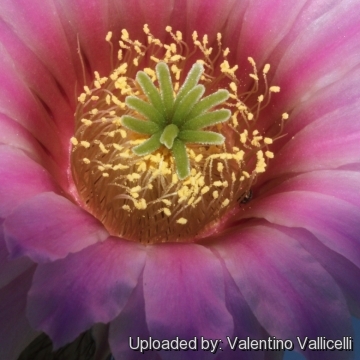 Filaments greenish, style white, stigma lobes green. Photo by: Valentino Vallicelli
Filaments greenish, style white, stigma lobes green. Photo by: Valentino Vallicelli - (San Estebán Island, Baia California, Mexico) It is one of the largest of the upright-stemmed hedgehog cacti, it is not the longest-stemmed, but it is the most massive. Plants in cultivation often grows for a long time with single solitary columnar stems. Photo by: Valentino Vallicelli
- (San Estebán Island, Baia California, Mexico) It is one of the largest of the upright-stemmed hedgehog cacti, it is not the longest-stemmed, but it is the most massive. Plants in cultivation often grows for a long time with single solitary columnar stems. Photo by: Valentino VallicelliSend a photo of this plant.The gallery now contains thousands of pictures, however it is possible to do even more. We are, of course, seeking photos of species not yet shown in the gallery but not only that, we are also looking for better pictures than those already present.
Read More... Cultivation and Propagation: This cactus is cultivated and highly priced for its flowers and tall columnar gold spined stems. It is among the easiest species to grow, flower and propagate but a slow grower. Water regularly from March to October. Rot prone in winter, it needs good drainage. It prefers a deep pot. It is though a holy terror when you attempt to repot it, even the slightest touch seems to break off the spine clusters, a very difficult issue to avoid if you are moving a larger plant! Unfortunately, this tendency also permanently marks the plant and be aware that such faults are not necessarily due to poor cultivation! but in the greenhouse we will normally cut it and re-root its top when it gets too long. The base, of course, will produce more pups which can also be taken and re-rooted. It require strong sunlight to maintain a healthy appearance, and a harsh "dry and cool" winter environment combined with maximum light exposure enhances spring flower production. Avoid freezing temperature.
Propagation: Seeds or cuttings if available.
Uses: Fleshy parts where used for candles.















